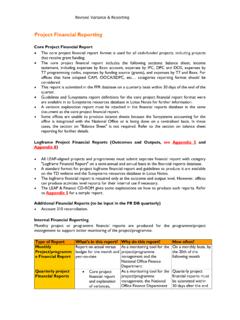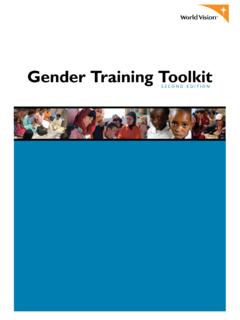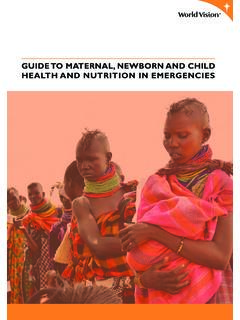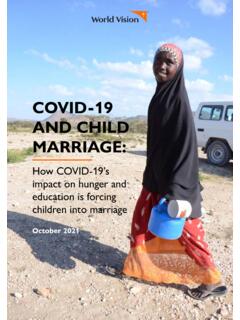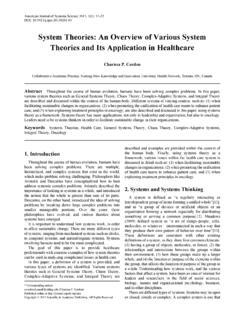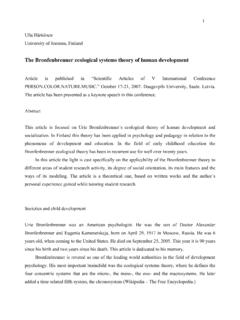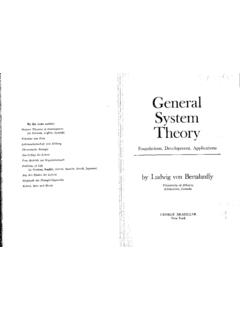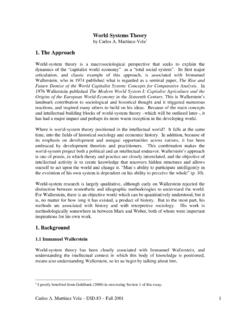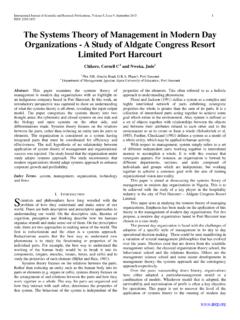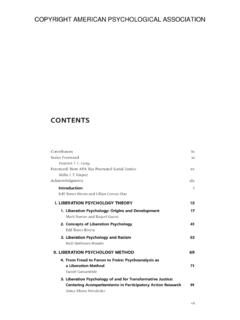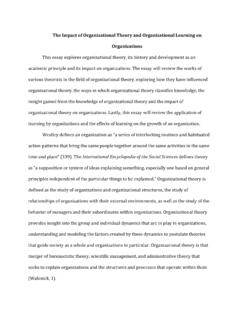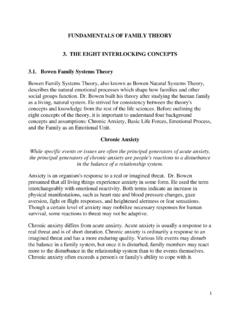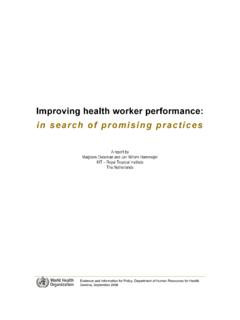Transcription of Child Protection Theory of Change World Vision
1 Child PROTECTIONTHEORY OF CHANGEW orld Vision InternationalJune 2014 Child Protection Theory OF CHANGEWORLD Vision INTERNATIONAL - JUNE 201423 The goal of Child Protection is To strengthen the Protection of children from abuse, neglect, exploitation and other forms of violence. Child Protection is critical for all Child well-being (CWB) Aspirations and Outcomes. Violence or exploitation can undermine any other Child well-being outcome, just as a safe environment provides children with the opportunity to develop across all the outcomes. Also, adverse childhood experiences (such as abuse, exploitation and neglect) are shown to have long-term consequences on well-being and behaviour.
2 The consequences often include difficulties in school/learning, poor health and problems in gaining employment and interacting socially, frequently for their whole lives. Sustained improvement in all of WV s Child Well-Being Targets requires Protection of children from violence and Theory of Change that is described in this document reflects the changes at various levels that need to occur to lead to the Protection of children from abuse, neglect, exploitation and other forms of violence. This is much broader than WV s ministry; WV will only contribute to some elements that are required for Change . No Change can be directly attributed to WV.
3 Rather, our level of contribution will vary from significant to minor depending on the is also important to note that this Theory of Change reflects our current understanding of how Change takes place. As we mature in our experience in Child Protection across many contexts, with an increasing focus on evidence building, our confidence in this Theory of Change should improve. As we learn from our monitoring and evaluation data, targeted research, and other information, we will most likely Change elements of this Theory , and increase our confidence in other elements. The Theory of Change is a tentative statement that is subject to ongoing refinement and adjustment as we learn our way This section is adapted from World Vision s Theory of Change (2011).
4 How will it help us?The Theory of Change provides the basis for a number of aspects of our work. It can help to unite or link the contributions of different sectors and lines of ministry to Child Protection outcomes. The Theory of Change can also be a valuable guide in developing strategy; it can help offices think through the numerous possible entry points to strengthening protective environments, and link efforts at different levels into a more coherent strategy. Just like a business that works out its business model by determining where it will add value to the value chain, so too WV offices and programmes can utilize the Theory of Change to consider the many types of interventions that contribute to Child Protection outcomes, determine how and where it is likely to make an impact, and scope its work on Child Protection with reference to the overarching Change process that has been mapped in the Theory of Change .
5 Each entity, sector or program will be able to determine what particular capabilities it has that allow it to add value to aspects of the Change process. In other words, the Theory of Change can help WV to decide where it will focus, where it will partner, and what it will and will not contribute to - at the organisational level, national, sector and program levels. This of course will also be very important in the development of Technical Approaches which are seeking to impact violence or exploitation of children. The Theory of Change can also provide a framework to guide evidence building and learning on Child Protection . We will be developing a monitoring and evaluation framework to measure Change at the various levels of the Theory of Change .
6 Also, all research and action learning in Child Protection should contribute to refining this Theory of Change , with special priority given to the 3 X 3 Essentials below. The Theory of Change can also be used in capacity building, so that staff are able to envision and dive deeper into the many joined-up elements contributing to Child Protection . It should be used as a framework to guide all programming and advocacy guidance. And it can provide compelling evidence to potential donors that WV is technically robust in the field of Child WHY DO WE NEED A CP Theory OF Change ?1 Child Protection Theory OF CHANGEWORLD Vision INTERNATIONAL - JUNE 201445As mentioned above, this Theory of Change is broader than World Vision s ministry, and reflects the efforts of many actors in complex systems.
7 World Vision and partners utilize strong analytical tools to identify specific and appropriate entry points to leverage systemic Change in each context. However, across all contexts, our approach to Child Protection seeks to empower children, families, communities, governments and other partners to prevent and respond to exploitation, neglect, abuse and other forms of violence affecting children, especially the most vulnerable. We take a systems approach to Child Protection , helping to strengthen the protective environment around children, as well as the children themselves. This includes a focus on the formal elements (for example, national legislation and policy frameworks, legal services and social welfare services) and informal elements (for example, churches, community based organizations, indigenous leaders and children/youth networks) that work together to prevent and respond to abuse, neglect, exploitation and other forms of violence against children.
8 Our programmatic work and expertise at the local level gives us the credibility and evidence to advocate for stronger Child Protection systems on national, regional and global level. A systems approach seeks to do the following: 2 Address Child Protection issues in a comprehensive and sustainable manner, including cultural, political, social, spiritual and financial factors. Affirm the role of parents (both mothers and fathers) and caregivers as those first responsible for care and Protection of children. Affirm the responsibility of States to guarantee the care and Protection of children, through respecting, protecting and fulfilling their Protection rights outlined in the Convention on the Rights of the Child and other international human rights instruments.
9 Affirm the critical contribution of non-formal actors to protective norms and behaviours, including especially the influence of faith communities. Affirm the role of children as the final measures of the effectiveness of Child Protection , and as critical actors in protecting themselves and their peers. Strengthen the protective environment for all children, including a strong focus on prevention of abuse, exploitation, neglect and other forms of violence against children. Leverage local level work to strengthen Child Protection systems on national, regional and global levels. A systems approach to complex Change must always operationalize the following principles: See the whole/big picture See that different parts of the system affect each other See various different ways/entry points to Change a situation Understand that worldview and beliefs affect how people act and choices they make Take a long-term view Practice continual learning and make regular addition to strengthening Child Protection systems, World Vision addresses the root causes of Child Protection issues (as assessed in each particular area), through targeted interventions by other sectors.
10 This includes addressing family stress, lack of hope, financial drivers of harmful behaviours, discrimination and inequitable access to services or resources, and other factors which contribute to abusive, exploitative or neglectful behaviours. Evidence and our experience tell us that Child Protection issues are critical for children (especially the most vulnerable) everywhere that we work. We therefore aim to apply this approach to strengthening the Protection of children not only through projects focused on especially vulnerable groups or specific issues ( children who are trafficked), but also as a core part of all community-based programming, humanitarian efforts, and advocacy work for Child well-being.
